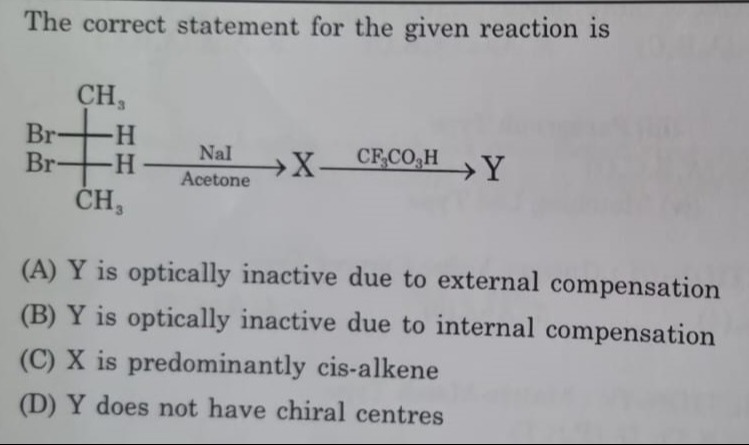Question
Question: The correct statement for the given reaction is ...
The correct statement for the given reaction is

Y is optically inactive due to external compensation
Y is optically inactive due to internal compensation
X is predominantly cis-alkene
Y does not have chiral centres
Y is optically inactive due to internal compensation
Solution
The starting material is (2S,3R)-2,3-dibromopentane. The reaction with NaI in acetone is a dehalogenation reaction of vicinal dibromides to form an alkene. This reaction proceeds via an E2 mechanism involving anti-periplanar elimination of the two bromine atoms.
The product X is pent-2-ene, CH3-CH=CH-CH3. The substituents on the double bond are H and CH3 on each carbon. E-pent-2-ene has the two CH3 groups on opposite sides of the double bond.
CF3CO3H is trifluoroperoxyacetic acid, which is a peroxy acid. Peroxy acids react with alkenes to form epoxides (oxiranes). This reaction is a syn addition of oxygen to the double bond.
Since X is E-pent-2-ene, the reaction with a peroxy acid will form an epoxide. The epoxide formed from E-alkene by syn addition is a meso compound if the alkene is symmetrical and has identical groups on both sides of the double bond.
The epoxide is 2,3-epoxypentane.
O
/
CH3-CH-CH-CH3
This molecule has a plane of symmetry passing through the oxygen and the midpoint of the C-C bond.
A meso compound is optically inactive due to internal compensation. It has chiral centers but is achiral due to the presence of a plane or center of symmetry. So, Y is optically inactive due to internal compensation.
